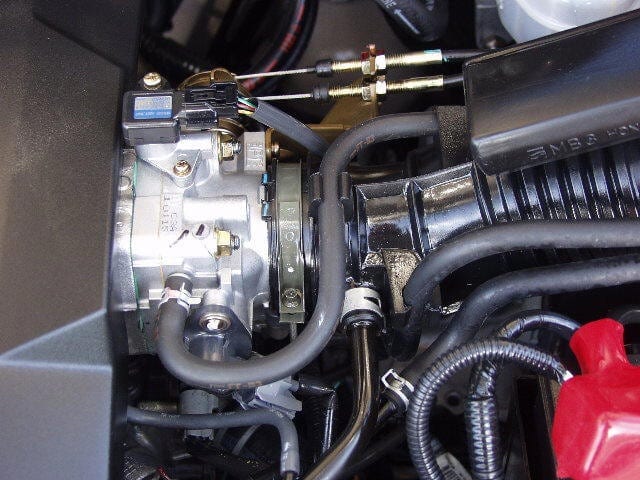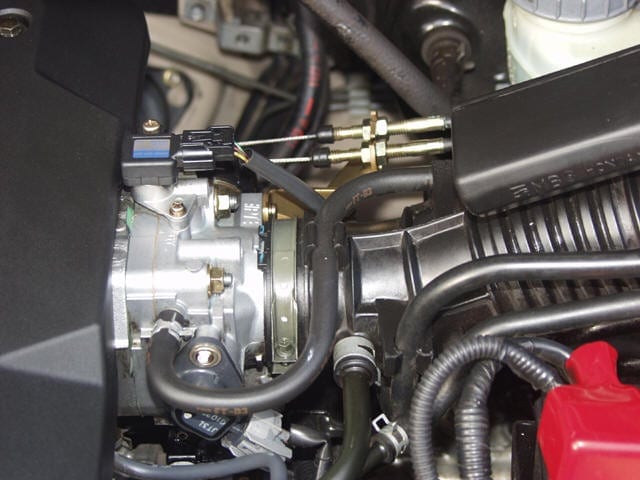Autos & Motorcycles
Short Directions
- Make sure surface to be treated is relatively clean and dry. If the undercarriage is covered with mud a wash down with a water spray is recommended. The surface does not need to be completely free of water when applying TC-11.
- Shake the aerosol two or three times.
- Apply a thin layer of TC-11 to the metal parts in the engine compartment,.Apply a heavy coat of TC-11 to the transmission, universal joints, differential. suspension components, exhaust system downstream of the catalytic converter, brake drums, and the electrical system.
- Do not apply TC-11 to heat exchanger fins such as the radiator or A/C condenser.
- Do not apply TC-11 to disc brake rotors.
- At three to six month intervals, wash down engine compartment with a high pressure low volume spray, allow area to dry, and re-apply TC-11 film.
- Once a year, clean engine compartment with a mild surface cleaner. Allow area to dry. Since the engine compartment is free of water, oil, and dirt, this is an excellent to do any painting work that may be required. Re-apply TC-11 film.
TC-11 is a practical and efficient solution for keeping your vehicles in the best of condition at all times.
Detailed Instructions
Introduction
TC-11 completely changes the vehicle ownership experience. By using TC-11 it is possible to significantly extend the lifetime of the vehicle and to significantly reduce maintenance and repair costs.
Internal Lubrication versus External Lubrication
Internal lubrication failures are nowhere near as common as they used to be. In the “good old days”, new engines were full of contamination from the manufacturing process. The loads on the bearings were not completely understood. The thermal expansion and contraction of the internal parts was not fully understood.
Modern engines are built in clean room conditions. Computer modeling has evolved to the point that the rotating components are analyzed almost down to the molecular level. Real world test results are used to refine the extremely accurate computer simulations.
In addition, engine oil additives are available that come close to reversing the wear process. Metal or plastic particles in the additive precipitate on the rotating parts, and the lubricating film can’t tell the difference between the original metal and the precipitate. Since the loads on the engine go through the lubricating film, this means that it is possible to extend the design lifetime of the engine by 100% or more. The only item that is susceptible to failure is the transmission. Transmissions are relatively inexpensive to overhaul or replace, so the driveline of a well maintained modern vehicle will last 200,000 miles or more.
External Lubrication
Rust is a lot like cancer. Once it gets past a certain point, it is impossible to stop. A vehicle is scrapped when the corrosion level reaches the point that it is too expensive to continue to operate the vehicle.
As engine designers eliminate oil leaks, corrosion problems increase. Older vehicles had a coat of motor oil on the undercarriage that was relatively effective at preventing corrosion on suspension and steering components. New engines are virtually leak free, and the result is an increase in the amount of corrosion on the undercarriage.
New Vehicles
Using TC-11 on new vehicles is a simple matter of “painting” the metal parts in the engine compartment with TC-11. It is a good idea to apply TC-11 to the non-undercoated parts undercarriage. This means that the first film that forms on the vehicle undercarriage is a reducing film (hydrocarbon rich and protective) and not an oxidizing film (oxygen rich and destructive), or a salt film (chlorine rich and highly destructive).
It is a good practice to apply a quality plastic preservative to the plastic and rubber parts in the engine compartment prior to applying TC-11 to the metal parts. Modern engines compartments have a lot of plastic in them. Automotive engineers like plastic because in addition to being very inexpensive and light, it doesn’t corrode. TC-11 certainly doesn’t hurt plastic, paint, and rubber; but it is a metal protection product first and foremost. Tc-11 actually replaces the plasticizers that are lost die to heat and ozone attack, so rubber parts (such as constant velocity joint boots and steering rack boots) that are treated with TC-11 maintain their original strength and flexibility indefinitely.
It is not necessary to apply a thick film to parts in the engine compartment. TC-11 does not have a vapor pressure to speak of. This means that a thin film will last three to six six months in an engine compartment. By washing down the engine and re-applying the TC-11 film at three to sic month intervals the effectiveness of the TC-11 film is a certainty.
Do not apply TC-11 to heat exchanger fins such as engine coolant radiators, air conditioning condensers, or oil coolers. TC-11 can interfere with the film coefficient of the fin surface. Painting the fins surfaces is the recommended method of dealing with corrosion problems. Manufactures use relatively low quality paint to protect the fin surfaces, since they are either aluminum or copper, which are much more corrosion resistant than steel. Aluminum exfoliates and copper forms a patina, so they are not even remotely corrosion proof. Any aftermarket radiator should be painted to avoid corrosion problems. The reduction in the heat rejection capacity of the radiator will drop by one percent or less is it is painted, even with a thick coat of paint. If corrosion takes place on the fin surface, the heat rejection capacity of the radiator can drop by 50% or more. Radiator leaks can be repaired. Fin corrosion requires replacement of the entire radiator. Modern coolants are virtually corrosion free, so the corrosion problem is usually an external corrosion problem.
Do not apply TC-11 to disc brake rotors. The rust that forms on the rotor is superficial. TC-11 will interfere with the operating of the brake pad, so it is not a good idea to apply TC-11 to the rotor.
There are many parts of a vehicle that require special attention:
1. Hinge pins – use the Precision Applicator to place a few drops of TC-11 on the door, hood, and trunk hinge pins. Corrosion often starts at the hinge pins and works it way out to the thin sheet metal that hold the hinge.
2. Locks – a drop of TC-11 on the key once a year will keep the tumblers corrosion free and well lubricated for a year. DO NOT USE TOO MUCH TC-11, as it will accumulate dust.
3. Throttle cable – a small amount of TC-11 on the throttle cable will prevent corrosion and will lubricate the throttle cable and mechanism.
4. Battery terminals – a small amount of TC-11 on the battery terminals will keep the terminals completely corrosion free.
A picture of a new carburetor that has been treated with TC-11 is presented below.

A photograph of the same carburetor five years later is presented below. The vehicle was stored operated and stored in a location with a constant salt breeze. The metal parts are completely corrosion free. All of the plastic and rubber parts are in “like new” condition.

Older Vehicles
TC-11 is easy to use once the vehicle is clean. Cleaning the undercarriage is easy. A garden hose will do a great job of cleaning most undercarriages, and a pressure washer will handle even the dirtiest vehicles.
Engine compartments are a bit of a challenge the first time you clean them.
Cleaning an engine compartment is not all that easy, and mistakes can cause a lot of money.
One mistake to avoid is trying to clean a hot engine. If you hose down a hot engine, there is a good chance that you can crack the exhaust manifold or break one of the bolts that attaches the manifold to the head. Either one is bad news and very difficult (i.e. expensive) to repair.
In addition, the heat tends to evaporate water and cleaners too quickly, so the effectiveness of the cleaning process itself is reduced.
Until TC-11 is applied the electrical system is very sensitive to water. The way the connectors are designed, water shorts out the connector as soon as it touches the connectors. It can take days or weeks for the component to dry out, and the water will start the corrosion process.
The ignition system is highly susceptible to failure as soon as water touches the coil, distributor, or spark plug wires. The spark that is supposed to ignite the fuel/air mixture in the cylinder finds an easier path to the ground through the water film on the engine. The engine degreaser manufacturers are very careful to warn users about this, and they actually recommend putting aluminum foil over the ignition coil, distributor cap, ignition wires, and spark plugs for this very reason.
These problems disappear once TC-11 is applied. The TC-11 film makes it impossible for water to get close enough to the ignition system connectors to conduct the electrical impulse from the connector to the engine block. In addition, all of the low voltage components -and there are hundreds of them – are no longer susceptible to shorting out if water touches them. With TC-11 you can hose down your engine compartment without any concern about electrical problems. This allows you to have an engine compartment that looks better, is much easier to work on, and is not subject to corrosion related problems.
Once the engine compartment is clean and dry, simply spray a light coat of TC-11 on the metal components. The engine compartment will look as if it has just been painted with clear paint when TC-11 is applied correctly.
After three to six months, go back and hose off the engine. Most of the TC-11 will remain in place, but the dirt, salt, and corrosion that has been removed from the engine will come off. Allow the engine to dry, and re-apply TC-11.
Once a year, it is a good idea to clean the engine with a mild surface cleaner. With TC-11, it is not necessary or recommended to use an engine degreaser at this point. Engine degreasers are very aggressive, and they can cause damage to rubber and plastic parts. Some degreasers will eat right through aluminum, so they are to be used with caution. It is also necessary to rinse the engine compartment thoroughly. The solvent properties of degreasers will continue indefinitely if they are allowed to remain in place. The goal is to have the degreaser remain in place long enough to remove the grease but not long enough to affect the rubber and plastic. It is very important o avoid contact between the degreaser and the finish paint coat.
After the annual cleaning, the engine compartment is dirt free, oil free, and corrosion free. This is a great time to do any painting that may be required.
Motorcycles
- Spray rusted area with TC-11.
- Use 0000 steel wool to agitate surface.
- Wipe area with a paper towel or a cloth.
The remaining TC-11 film will prevent the rust from returning.
0000 steel wool is usually used to polish varnish prior to re-coating. The steel fibers are much softer than the chrome finish, so the 0000 steel wool will not mar or scratch the chrome surface.
TC-11 penetrates into the spoke/rim interface in order to prevent corrosion. TC-11 does not adversely affect the rubber tire.
If the surface picks up dust the TC-11 film is too thick. Hose off the area with a garden hose nozzle.
TC-11 is optimized for drive chains. TC-11 dries into a non-evaporating and non-hardening film. The precision oiler is the best way to apply TC-11 to the chain. The aerosol will always apply more TC-11 than you need, even with the extension tube in place.
The precision oiler is optimized for pivots, cable ends, adjustment screws, threads, latches, and hinges.
Taking Care of A Bike with TC-11
TC-11 does not harm rubber, paint, or plastic. TC-11 will maintain the original condition of spark plug boots, ignition wires, wiring insulation, and other plastics indefinitely.
Use a quality rubber and plastic preservative (such as Turtle Wax Formula 2001) on plastic surfaces.
ICC manufactures a Degreasing Surface Cleaner that is optimized for TC-11 and the rubber and plastic preservative. It works in seconds, and it is relatively benign as far as compatibility with rubber, paint, and plastic is concerned. It is possible to clean the bike without actually touching it: the products and the water spray do all the work.

